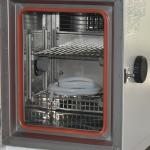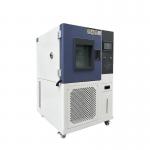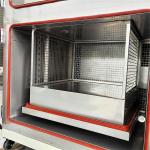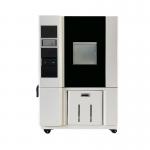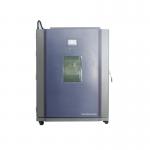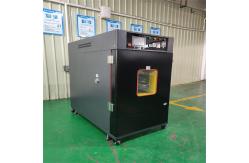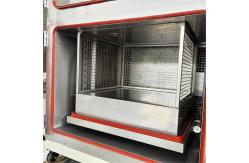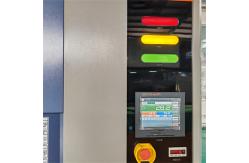In the realm of product testing and quality assurance, adhering to
international standards is of utmost importance. The customized
temperature humidity test chamber, designed to perform tests
according to ISO 16750-4, offers a reliable and accurate solution
for evaluating the performance and durability of various products
under specific environmental conditions. This advanced testing chamber is specifically engineered to
replicate the temperature and humidity conditions stipulated in ISO
16750-4. It serves a wide range of industries, including
automotive, electronics, and telecommunications. The primary
objective is to subject products to the defined temperature and
humidity profiles, enabling manufacturers and researchers to assess
how well the products will withstand the environmental stresses
they may encounter during their lifecycle. By conducting tests in
strict accordance with this international standard, companies can
ensure the quality and reliability of their products, enhance
customer satisfaction, and meet regulatory requirements. - Robust and Insulated Chamber Structure
- The test chamber is constructed with a heavy-duty steel frame that
provides exceptional rigidity and stability. The frame is coated
with a corrosion-resistant finish to prolong its service life. The
chamber walls are made of high-quality insulation materials, which
effectively minimize heat transfer and maintain precise temperature
and humidity levels. The insulation is carefully selected to
withstand the rigors of continuous testing and prevent any external
factors from interfering with the internal test environment. The
chamber is also equipped with a double-door system, with an inner
door made of transparent polycarbonate for easy visual inspection
during tests and an outer insulated door for enhanced sealing.
- Precision Temperature and Humidity Control System
- The chamber features a highly accurate temperature and humidity
control system. It can maintain a wide temperature range, from
-40°C to +150°C, with an accuracy of ±0.5°C. The humidity control
range extends from 10% to 95% relative humidity, with an accuracy
of ±3% RH. The system utilizes advanced refrigeration units,
electric heaters, humidifiers, and dehumidifiers to achieve and
maintain the desired environmental conditions. The temperature and
humidity sensors are strategically placed within the chamber to
provide real-time feedback, enabling the control system to make
rapid and precise adjustments.
- Customizable Interior and Fixtures
- The chamber offers a customizable interior space to accommodate
different sizes and shapes of test samples. It can be equipped with
adjustable shelves, racks, and mounting fixtures, allowing for
flexible test setups. The interior surfaces are made of
non-corrosive and non-reactive materials to prevent any
contamination or interaction with the test samples. Additionally,
the chamber can be fitted with various accessories, such as cable
ports, viewing windows, and access doors, to facilitate testing and
monitoring.
- Advanced Control and Data Acquisition Interface
- The equipment is equipped with an intuitive control panel and a
sophisticated data acquisition system. The control panel allows
operators to easily set and adjust the temperature, humidity
parameters, and test durations according to the requirements of ISO
16750-4. It provides real-time display of the current test
conditions and any alarms or warnings. The data acquisition system
records all relevant test data, including temperature and humidity
profiles, and any changes in the physical properties of the test
samples. The data can be stored in a built-in memory or exported to
external storage devices for further analysis. The system also has
the ability to generate detailed test reports in various formats,
such as PDF or Excel.
- Compliance with ISO 16750-4 Standards
- The chamber is specifically calibrated and programmed to perform
tests in strict accordance with ISO 16750-4. It can replicate the
various temperature and humidity cycles, dwell times, and
temperature change rates specified in the standard. This ensures
that the test results are valid and comparable, allowing
manufacturers to make informed decisions about product design,
material selection, and quality control. The chamber also provides
a means for documenting compliance with the standard, which is
essential for product certification and market acceptance.
- Temperature Cycling Range
- The chamber can perform temperature cycling within the range of
-40°C to +150°C, as required by ISO 16750-4. This wide temperature
range allows for the simulation of various environmental
conditions, from extremely cold climates to hot and humid regions.
For example, in automotive testing, components may need to
withstand the cold temperatures of winter and the heat generated by
the engine and surrounding environment.
- Humidity Cycling Range
- The humidity cycling range of 10% to 95% relative humidity enables
the assessment of product performance under different moisture
levels. High humidity can cause condensation, corrosion, and other
moisture-related issues, while low humidity can lead to drying and
cracking. The chamber can accurately control the humidity levels
and cycle them according to the standard, providing a comprehensive
evaluation of product resistance to moisture.
- Temperature Change Rate
- The chamber can achieve a temperature change rate of up to 5°C per
minute, which is in line with the requirements of ISO 16750-4. This
rapid temperature change is crucial for simulating the sudden
temperature fluctuations that products may experience, such as when
a vehicle moves from a cold garage to a hot road or vice versa. It
helps to identify potential weaknesses in product design or
materials that may be affected by such rapid thermal changes.
- Testing Volume and Payload Capacity
- The chamber offers a customizable testing volume, with options
ranging from 1 m³ to 20 m³. The payload capacity can be adjusted
according to the size and weight of the test samples, with a
maximum capacity of up to 2000 kg. This flexibility allows for the
testing of a wide variety of products, from small electronic
components to large industrial equipment.
- Dwell Time Accuracy
- The chamber can maintain the specified dwell times at different
temperature and humidity levels with an accuracy of ±1 minute.
Dwell time is an important parameter in ISO 16750-4, as it
determines the length of time the product is exposed to a
particular environmental condition. Accurate control of dwell time
ensures that the test is conducted in accordance with the standard
and provides reliable results.
- Accurate Simulation of Environmental Conditions
- The primary function of the chamber is to provide a precise and
reliable simulation of the temperature and humidity conditions
defined in ISO 16750-4. By accurately replicating these conditions,
it allows manufacturers and researchers to evaluate the performance
and durability of products. For example, in the electronics
industry, it can be used to test the reliability of circuit boards
and components under different temperature and humidity stress
levels, ensuring that they will function properly in real-world
applications.
- Product Design Optimization and Quality Control
- Through a series of tests on different product prototypes, the data
obtained from the chamber can be used to optimize designs.
Manufacturers can analyze the behavior of various materials and
components under the specified environmental conditions and make
improvements. For instance, an automotive manufacturer can study
the effect of temperature and humidity on the performance of a new
sensor design and make adjustments to enhance its reliability. The
chamber also serves as a vital tool for quality control, ensuring
that each batch of products meets the required standards and
specifications.
- Research and Development Support
- In the field of research and development, the chamber offers
valuable insights. Researchers can use it to study the fundamental
properties of materials and the interactions between different
environmental factors and products. They can explore new materials
and technologies that are more resistant to temperature and
humidity. For example, a materials science research team may use
the chamber to test the performance of a new composite material and
analyze its potential applications in various industries.
|
